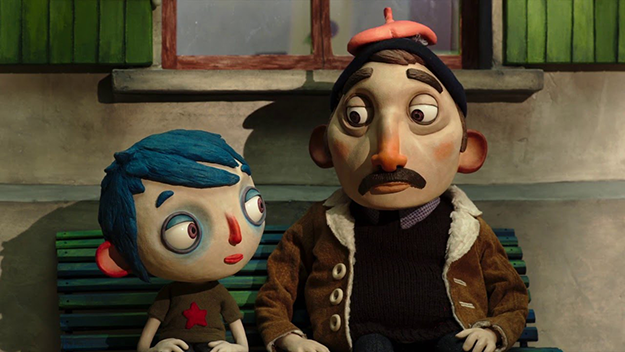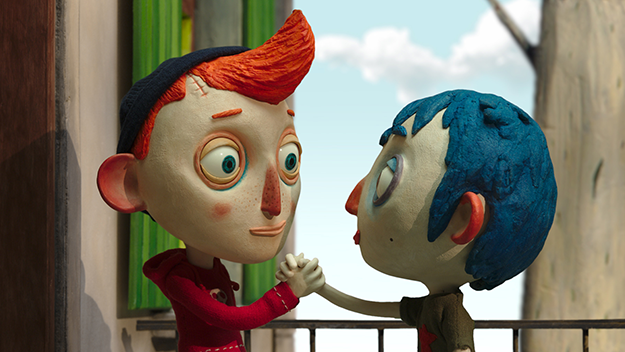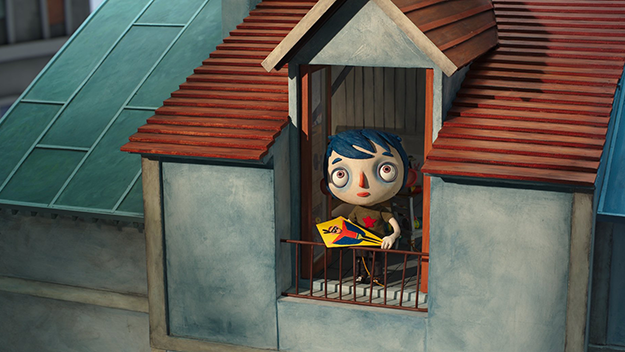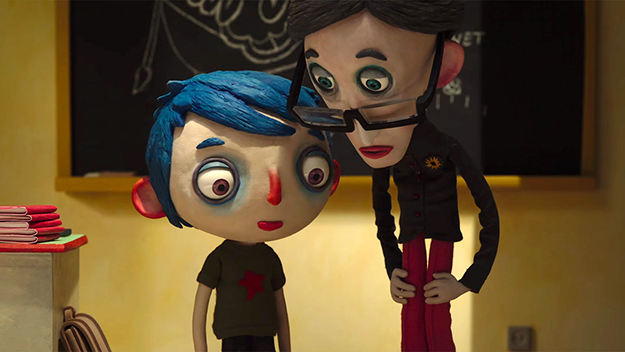Deep Focus: My Life as a Zucchini

My Life as a Zucchini is a modest marvel based on a novel by Gilles Paris called Autobiography of a Zucchini. Was this change in the title mean to evoke Lasse Hallström’s tough and funny 1985 coming-of-age film, My Life as a Dog? This stop-motion cartoon feature more than stands up to comparison, and not just because the two movies center on orphans. The hero, nicknamed “Zucchini,” is an unintentional matricide who gets sent to a care center that handles hard-luck cases of all kinds. As a group they’ve survived sexual abuse, addicted and crazy parents, and simply desperate mothers and fathers who stole to provide for their children or were abruptly deported. Director Claude Barras and writer Céline Sciamma maintain their sardonic humor and sensitivity even when their material is horrific. Their movie is a triumph of talent and poise.
It’s a wonderful touch that Zucchini’s real name is Icarus, like the mythic boy who flew too close to the sun. We first see him finishing a kite that pictures, on one side, the father who abandoned him as a caped superhero. On the other side he draws a chicken—because his mother told him that his father loves “the chicks.” His mother dubbed him Zucchini; he goes by it to respect her memory. Barras and Sciamma’s storytelling style is a marvelous blend of direction and indirection.
They give us time to notice the drawings of chickens and superheroes that line Zucchini’s attic room, just as they portray him building a pyramid of empty cans before we realize they’re all beer cans drained by his alcoholic mother. At first, the excruciating mishap that sets the film in motion registers as a frightened child slamming his door shut to block his raging, drunken parent from entering. Tragically, it’s an attic trap door, and it sits atop a ladder leading up to Zucchini’s room. The door slams down on his mother’s head. The realization of what he’s done dawns on him, and simultaneously, on us.

The movie clocks in at a taut 70 minutes, but it isn’t economical for its own sake. The way the film spurts ahead, then stops to breathe, reflects the stop-and-go progress of Zucchini and his new friends. The animation, done with 10-inch latex figures, silicone arms, resin faces, and, for clothes, real fabric, engages us with directness and subtlety. It’s emotionally forceful on the surface, but its deeper understanding of trauma creeps up on us.
Barras has said that Hergé, the creator of the comics series about the boy reporter and adventurer named Tintin, taught him that the more you pare down the details of a character’s face, the more an audience can project their own emotions onto it. That’s true, but his original choices for portraying his puppets’ human features account for much of the movie’s wit and poignancy. His characters’ big eyes don’t beg for sympathy, as they do in Keane paintings. Instead, they widen to take in the world. In Barras’s generous vision, even the most recessive or traumatized characters deep down yearn to connect, including the endearingly phlegmatic policeman, Raymond, who takes charge of Zucchini’s case and accompanies him to the orphanage. Each dab of color on a puppet’s cheek, every pucker or raised eyebrow in its sculpting, expresses both the delicacy and strength of the filmmakers and the vivid personalities of their heroes and heroines.
Even better, Barras has visualized his ensemble as a whole. Zucchini’s round face, blue hair, and thin red nose complement gruffly affectionate Raymond’s tawny coloring and jowly head. These two figurines share more chemistry than most human co-stars, and that goes for the orphanage kids and personnel, too. The surprises in My Life as a Zucchini come from its unsparing honesty about the kids’ plight and the unabashed optimism about their courage, ingenuity, and resilience. The no-nonsense headmistress, the young female aide who kisses each child goodnight, the earnest teacher who jovially instructs them about difficult concepts like evolution (leading to a hilarious “Cro-Magnon” party) all turn out to be terrific people, like Zucchini and Raymond.

In an inspiration worthy of the Aardman animators, Barras has cast his juvenile characters with nonprofessionals. The result is as fresh and endearing as hearing an unaffected children’s choir. What’s refreshing about My Life as a Zucchini is that it doesn’t strain to be “different;” even the obligatory getting-to-know-you scenes emerge in unusual ways. A redheaded hellion named Simon is a James Cagney–Mickey Rooney figure who calls Zucchini “potato” and dares to fly his kite without permission. But Barras isn’t moralistic about the hazing that Simon puts Zucchini through. Simon simply wants all his fellow misfits to lay their cards on the table. When Zucchini hesitates to disclose why he ends up in the orphanage, Simon tells him why everyone else is in there; he just needs to know where everyone is coming from. He doesn’t use the information to bully them, but to understand. It helps to know that a scarred girl who dramatically sweeps her blonde mop of hair across her brow suffered from an abusive dad, or that the hypochondriac Jujube, who puts Band-Aids on his head to cure his headaches, eats toothpaste because his OCD-plagued mother told him it was healthy.
Simon, whose bright red pompadour registers as a merry taunt, instinctively knows that the cohesion of this group depends on a peculiar combination of common knowledge and privacy. When a stellar soccer player named Camille shows up and immediately catches Zucchini’s eye, it’s Simon who persuades him to sneak into her file. Her case is particularly horrifying: she witnessed her parents’ murder-suicide. Later, she learns that Zucchini knows about it. It’s a miraculous scene. She blurts out her embarrassment in one giant spasm, then lets it pass. Her budding friendship with Zucchini includes sharing her past with him. It’s a poignant piece of bonding without an ounce of sap, partly because it’s more like an alliance, especially when Camille’s aunt attempts to take control of her in order to get the custody allowance.
The sequence depicting Raymond taking Camille and Zucchini to a carnival is a tiny masterpiece. At a shooting gallery the kids quietly realize why Camille proves to be such a crack shot. It’s part of her legacy from her father. When Raymond takes them on a spook-house ride, it doesn’t immediately register as a metaphor, which is why the metaphor is so touching. Garish bat-demons swarm around their car as Raymond hovers protectively from the seat behind them. Almost as moving is the entire orphanage’s trip to a mountain resort. Casually, it dramatizes the kids’ need to get out of their own heads and bodies. It’s ineffably satisfying to see Simon, especially, end up as a redheaded snowman. Moments that in lesser movies would be mawkish, such as the kids freezing in fascination as they watch a mom tend to her bruised child, come off as crystalline vignettes. Maybe that’s because this movie is as much about the solidarity of youth as the sadness of orphanhood.

Near the end, two children get the chance to be adopted. They hesitate to leave their friends and a benevolent institution. It’s Simon who tells them they have to go. They’ll be giving hope to troubled tweens who otherwise would think they’d never have a chance to get a new home of their own. My Life as a Zucchini has grace and charm, but what breaks your heart is its mental toughness.
Michael Sragow is a contributing editor to Film Comment and writes its Deep Focus column. He is a member of the National Society of Film Critics and the Los Angeles Film Critics Association. He also curates “The Moviegoer” at the Library of America website.







